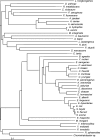AmpC beta-lactamases
- PMID: 19136439
- PMCID: PMC2620637
- DOI: 10.1128/CMR.00036-08
AmpC beta-lactamases
Abstract
AmpC beta-lactamases are clinically important cephalosporinases encoded on the chromosomes of many of the Enterobacteriaceae and a few other organisms, where they mediate resistance to cephalothin, cefazolin, cefoxitin, most penicillins, and beta-lactamase inhibitor-beta-lactam combinations. In many bacteria, AmpC enzymes are inducible and can be expressed at high levels by mutation. Overexpression confers resistance to broad-spectrum cephalosporins including cefotaxime, ceftazidime, and ceftriaxone and is a problem especially in infections due to Enterobacter aerogenes and Enterobacter cloacae, where an isolate initially susceptible to these agents may become resistant upon therapy. Transmissible plasmids have acquired genes for AmpC enzymes, which consequently can now appear in bacteria lacking or poorly expressing a chromosomal bla(AmpC) gene, such as Escherichia coli, Klebsiella pneumoniae, and Proteus mirabilis. Resistance due to plasmid-mediated AmpC enzymes is less common than extended-spectrum beta-lactamase production in most parts of the world but may be both harder to detect and broader in spectrum. AmpC enzymes encoded by both chromosomal and plasmid genes are also evolving to hydrolyze broad-spectrum cephalosporins more efficiently. Techniques to identify AmpC beta-lactamase-producing isolates are available but are still evolving and are not yet optimized for the clinical laboratory, which probably now underestimates this resistance mechanism. Carbapenems can usually be used to treat infections due to AmpC-producing bacteria, but carbapenem resistance can arise in some organisms by mutations that reduce influx (outer membrane porin loss) or enhance efflux (efflux pump activation).
Figures




References
-
- Abraham, E. P., and E. Chain. 1940. An enzyme from bacteria able to destroy penicillin. Nature 146:837. - PubMed
-
- Adler, H., L. Fenner, P. Walter, D. Hohler, E. Schultheiss, S. Oezcan, and R. Frei. 2008. Plasmid-mediated AmpC β-lactamases in Enterobacteriaceae lacking inducible chromosomal ampC genes: prevalence at a Swiss university hospital and occurrence of the different molecular types in Switzerland. J. Antimicrob. Chemother. 61:457-458. - PubMed
-
- Ahmad, M., C. Urban, N. Mariano, P. A. Bradford, E. Calcagni, S. J. Projan, K. Bush, and J. J. Rahal. 1999. Clinical characteristics and molecular epidemiology associated with imipenem-resistant Klebsiella pneumoniae. Clin. Infect. Dis. 29:352-355. - PubMed
-
- Ahmed, A. M., and T. Shimamoto. 2008. Emergence of a cefepime- and cefpirome-resistant Citrobacter freundii clinical isolate harbouring a novel chromosomally encoded AmpC β-lactamase, CMY-37. Int. J. Antimicrob. Agents 32:256-261. - PubMed
Publication types
MeSH terms
Substances
LinkOut - more resources
Full Text Sources
Other Literature Sources
Medical
Molecular Biology Databases

